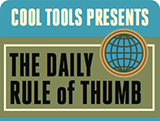Vagabonding
Tools for Possibilities: issue no. 122
Once a week we’ll send out a page from Cool Tools: A Catalog of Possibilities. The tools might be outdated or obsolete, and the links to them may or may not work. We present these vintage recommendations as is because the possibilities they inspire are new. Sign up here to get Tools for Possibilities a week early in your inbox.

Long-term global travel
Round-the-world travel was my occupation for many years. It’s an admirable vocation ignored by the travel industry and travel media. They think in terms of two weeks not two months or two years. Ignore the country-specific info in this thick tome as out of date [Note: the new edition of this book should have fixed this issue.–OH], but do pay attention to his airline ticketing advice, and his general wisdom about long-term travel. To anyone planning to take some serious time off to explore the far world at a cut above Stompers, start with this book. And then leave it at home. — KK
Some people are afraid to have a gap in their resum . Don’t worry about it. Don’t leave a gap in your resum , either. More and more, I hear from returned travelers who are putting their travel experience at the top of their resum : “A year spent traveling the world, familiarizing myself with the diversity of world cultures, and learning how to understand and deal with people from backgrounds different from my own.” Prospective employers may smile, they may laugh, they may be jealous – but they will offer you the job.
- Every guidebook I’ve read describes Tashkent, Uzbekistan, as completely without touristic interest – a big, industrialized city. Too civilized. Too modern. Not quaint. Too fast-moving. Too aware of the rest of the world. Too much of an ethnic mix to give one a proper sense of “pure” Uzbek culture. All accurate descriptions. Most tourists don’t like Tashkent, for just these reasons.
Reading the guidebooks’ denunciations, I knew immediately that Tashkent was the place for me. I found it was everything I had hoped for. I didn’t find a mythic past in Tashkent, but I wasn’t looking for the past. Tashkent is the future of Central Asia, all brought together in one bustling, cosmopolitan , accessible m lange: an intellectual and ideological center; the largest and richest city north of the Himalayas between Beijing and Moscow; a magnet for the best, brightest, and most ambitious people of a dozen nationalities from a thousand miles around. And, as of early 2000, US citizens no longer need a sponsor in order to obtain a visa for Uzbekistan. - My rule of thumb for guidebook prices is to add 20 percent to prices in a newly revised guidebook plus 10 percent for each year since the copyright. It adds up fast: if in 2003 you’re using a 2000 guidebook, expect prices to be 50 percent higher than in the book.
- Where there is a train, take it. Don’t think twice about the choice. In comparison with rail travel, road travel is dangerous, polluting, and expensive.
“Comfort, Safety, Speed” was the slogan of the Pacific Electric Railway, the Los Angeles and Southern California streetcar and interurban system that was once, believe it or not, the world’s largest. Comfort safety, and speed are the advantages of trains over road vehicles. Even where cars or buses are faster, comfort and safety – especially safety – are the reasons I still travel by rail where I can. - Hiring a driver greatly reduces your legal and financial liability. It is thus, in a certain sense, the most effective and often the cheapest form of insurance. If you are driving a car, you are responsible for complying with all the local ownership, licensing, tax, and insurance requirements, and for having all the related paperwork in order.
- Myth 5: “Tickets will be cheaper locally”
Many people have heard that tickets in some places are cheap and mistakenly conclude that it will be cheaper to buy parts of their tickets en route than to buy them before they leave. Those same tickets can probably also be obtained cheaply in advance, sometimes much more cheaply than if bought en route. - Big Business and the People’s Airline.
Travelers often wonder why all major international airlines seem to be set up to cosset the rich luxuriously and expensively. How come a major international airline isn’t committed to affordable, no-frills transportation for the masses? But there was, and to some degree still is, just such an airline: Aeroflot, the national airline of Russia. Why is Aeroflot different? Because it does things differently,
Aeroflot often seems a strange airline, and in some respects it is. It doesn’t know much about marketing, and it is often hard to deal with. But travelers who want to keep no-frills long-haul air transportation available as an alternative to expensive luxury owe it to themselves to at least consider Aeroflot (http:/www.aeroflot.org) and Russian aircraft where they are an option. - But if you want the cheapest possible roundtrip from the US to India, Ireland, Nigeria, or any other place from which there are large numbers of immigrants, no general-purpose agency, even a general discount agency, is likely to be able to beat the lowest prices of a no-service, bare-bones, specialist agency within that particular ethnic community that sells nothing else but a massive volume of roundtrip tickets to a single destination.

Not a vacation
We used to call ourselves drifters, or freaks, but “stompers” works just as well. Stompers are young, nomadic travelers having a great deal of fun meandering around the world, hanging out, partying in run-down grass shacks in exotic places, hooking up with each other, paying attention to the local scene, while ignoring boundaries. It is more a lifestyle than a vacation. Once centered mostly in Europe during the summer, the entire world from Ghana to Laos is now stomping grounds. This book is subversive, irreverent, bombastic, self-published, and full of the best advice I’ve seen in print for global vagabonds. It assumes you have very little money, but a whole lot of time and are open to new experiences. Average trip of a stomper: one year. What I like about the author, Brad Olsen, is that he seems to have made every possible mistake, but learns quickly from them.
Here’s the acid test: If you need to sleep in a bed on your world tour, The Practical Nomad is more your speed (and mine, too, these days). If you don’t care where you lay your sleeping bag down for the night, and you intend to be on the road for more than a month, this is the owner’s manual for you. — KK
- One Summer when Tommy P. and I lived in Lake Tahoe, we made a bet. We bet five bucks on whether he could last a whole month without spending a single cent on food. He worked as an usher for Caesar’s Showroom and was allowed free meals. Security was laid back and lax, so he would munch hard before and after his shifts and smuggle out pocketfuls of fruit, yogurts, puddings, cereal, milk and fruit drinks. I would barter meals with him on his days off to give him a variety, but never any freebies. The bet was only to pay for food.
Well he lost the bet a few days short of a month because he was fired from his job. He got the ax because he got up on stage and danced with Diana Ross during the encore. His boss did not believe she pointed at him for a dance. - The World’s Top 10 Best Stoner Meccas:
10. The whole country of Laos
9. Dahab, Egypt (page 220)
8. Nimben, Australia (page 179)
7. The ski mountains of Lake Tahoe, CA USA (page 151)
6. Tuk Tuk Peninsula, Lake Toba, Indonesia (page 189)
5. Pokhara, Nepal (page 241)
4. San Pedro, Guatemala (page 158)
3.The Whole Country of India (excluding the cities) (page 244)
2. The state of Alaska, USA (page 153)
1.The whole country of The Netherlands (page 206) - Rip-offs are rampant for people commando-crashing outdoors, particularly in Europe. Backpacks are taken, money belts being used as pillows are unzipped and cleared of contents, and even shoes are swiped. If you are going to Europe on a low-budget and plan to sleep outdoors part of the time, consider a few tips. First, it is always best to sleep in a group. There is definitely safety in numbers. Second, sleep with your money belt inside your sleeping, but not all the way at the bottom. There have been incidents of thieves feeling the bottom of a sleeping person’s sleeping bag for a money belt, then cutting the bag open with a knife and removing it. Third, chain your backpack to something, lock all the zippers, and try to use part of it as a pillow. Lastly, wherever sleeping with a group, lock all the packs together in the middle and position yourselves like spokes around a wheel hub. Detour thieves by making it hard for them to steal anything.

How to travel cheaply
The World’s Cheapest Destinations
So much to see, so little time. You won’t ever see it all, so why not select your destination by how inexpensive it is, thus maximizing your journey? You can spend two weeks in Europe, or 6 months elsewhere. Your choice. Travellers who choose the latter have far more fun, learn more, and bring dollars where it can do the most good. Rock-bottom prices also transform budget travel in these areas into luxury travel. This thin guide is a good investment for this approach. It lists 21 of the world’s cheapest countries for travelers with more time than money, with a brief idea of what to expect. Stick to these few and you’ll still have a lifetime of adventures. — KK
[The author’s website has some interesting and helpful links for bottom-fed travel: http://worldscheapestdestinations.com/]
- Indonesia
Prices plunged to a ridiculous level in the midst of the Asian currency crisis — when my wife and I needed five weeks of travel to spend $350, despite living it up. - India
We paid a dollar a night for a great room with bath in Jaisalmer, then found out the guys next to us had bargained the owner down to 65 cents! - Morocco
A cheapie room in a basic cold-water hotel starts at around $4 in the villages andaverages $7-$10 in the cities. The worst hotel we stayed in was $8 and the best onewe stayed in was $8. It just depends on where you are.

Tips for globe-trotting surfing
The Surfer’s Journal is pure surfing. For about 10 years now, Steve and Debbee Pezman have been sharing their love of the ocean and waves with other like-minded water people. A unique feature is the absence of advertising except for 2-3 pages from companies that surfers respect, like Patagopnia and Billabong. (By contrast a recent Collector’s Edition of Surfing mag, in listing what it called “The 25 Most Powerful People in Surfing” had almost half its list composed of CEO’s of surfboard or surf apparel companies.) The photography is stunning (a lot of credit going to photo editor Jeff Devine), the articles are in-depth, and there are a lot more longboard shots than the more typical punching-through-the-lip shortboard aerials that dominate the other surf mags. There’s also a lot of wonderful stuff from the past; it’s amazing that after all this time they still come up with unique shots from the 50s and 60s and sometimes earlier, when life was simpler and waves were uncrowded. The soul of surfing, 5 times a year. It’s the only magazine where I’ve saved every copy. — Lloyd Kahn
01/27/25





